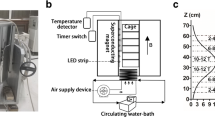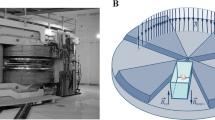Abstract
Objectives
We aimed to evaluate the biological effects of high static magnetic field (HiSMF, 2–12 Tesla [T]) exposure on mice in a stable and effective breeding environment in the chamber of a superconducting magnet.
Methods
C57BL/6 mice were bred in the geomagnetic field and HiSMF with different magnetic field strengths (2–4 T, 6–8 T, and 10–12 T) for 28 days. The body weight, blood indices, organ coefficients, and histomorphology of major organs were analyzed.
Results
The results showed that the HiSMF had no significant effect on the body weight, organ coefficients, or histomorphology of major organs in mice. The HiSMF had no effect on most routine blood and biochemical indices, but the value of the mean corpuscular hemoglobin (MCH) was increased in the 2–4 T group compared with that of the other groups, and the uric acid level (UA) was decreased in the three HiSMF groups compared with that of the control group.
Conclusion
The C57BL/6 mice were not affected when they were exposed to different HiSMF environments for 28 days.
Key Points
• No physiological problems were observed in mice with long-term whole-body exposure to HiSMF.





Similar content being viewed by others
Abbreviations
- ALB:
-
Albumin
- ALT:
-
Alanine aminotransferase
- BUN:
-
Blood urea nitrogen
- CHOL:
-
Total serum cholesterol
- CREA:
-
Creatinine
- CT:
-
Computed tomography
- GMF:
-
Geomagnetic field
- HGB:
-
Hemoglobin
- HiSMF:
-
High static magnetic field
- MCH:
-
Mean corpuscular hemoglobin
- MCV:
-
Mean corpuscular volume
- MRI:
-
Magnetic resonance imaging
- PDW:
-
Platelet distribution width
- PLT:
-
Platelet count
- RBC:
-
Red blood cell count
- RDW-CV:
-
Coefficient variation of red blood cell volume distribution width
- SMF:
-
Static magnetic field
- TBIL:
-
Total bilirubin
- TG:
-
Triglyceride
- UA:
-
Uric acid
- WBC:
-
White blood cell count
References
Stuchly MA (1986) Human exposure to static and time-varying magnetic fields. Health Phys 51(2):215–225
Lohmann KJ (2010) Q&A animal behaviour magnetic-field perception. Nature 464(7292):1140–1142
Heinrich A, Szostek A, Nees F, Meyer P, Semmler W, Flor H (2011) Effects of static magnetic fields on cognition, vital signs, and sensory perception: a meta-analysis. J Magn Reson Imaging 34(4):758–763
Yamaguchi-Sekino S, Sekino M, Ueno S (2011) Biological effects of electromagnetic fields and recently updated safety guidelines for strong static magnetic fields. Magn Reson Med Sci 10(1):1–10
Mészáros S, Tabák AG, Horváth C, Szathmári M, László JF (2013) Influence of local exposure to static magnetic field on pain perception and bone turnover of osteoporotic patients with vertebral deformity - a randomized controlled trial. Int J Radiat Biol 89(10):877–885
International Commission on Non-Ionizing Radiation Protection (2009) (2009) Guidelines on limits of exposure to static magnetic fields. Health Phys 96(4):504–514
Chakeres DW, Kangarlu A, Boudoulas H, Young DC (2003) Effect of static magnetic field exposure of up to 8 tesla on sequential human vital sign measurements. J Magn Reson Imaging 18(3):346–352
Balchandani P, Naidich TP (2015) Ultra-high-field MR neuroimaging. AJNR Am J Neuroradiol 36(7):1204–1215
Eryaman Y, Zhang P, Utecht L et al (2018) Investigating the physiological effects of 10.5 Tesla static field exposure on anesthetized swine. Magn Reson Med 79(1):511–514
Nowogrodzki A (2018) The world’s strongest MRI machines are pushing human imaging to new limits. Nature 563(7729):24–26
de Vocht F, van-Wendel-de-Joode B, Engels H, Kromhout H (2003) Neurobehavioral effects among subjects exposed to high static and gradient magnetic fields from a 1.5 Tesla magnetic resonance imaging system--a case-crossover pilot study. Magn Reson Med 50(4):670–674
Atkinson IC, Renteria L, Burd H, Pliskin NH, Thulborn KR (2007) Safety of human MRI at static fields above the FDA 8 T guideline: sodium imaging at 9.4 T does not affect vital signs or cognitive ability. J Magn Reson Imaging 26(5):1222–1227
de Vocht F, Batistatou E, Mölter A et al (2015) Transient health symptoms of MRI staff working with 1.5 and 3.0 Tesla scanners in the UK. Eur Radiol 25(9):2718–2726
Lepsien J, Müller K, von Cramon DY, Möller HE (2012) Investigation of higher-order cognitive functions during exposure to a high static magnetic field. J Magn Reson Imaging 36(4):835–840
Zilberti L, Bottauscio O, Chiampi M (2016) Assessment of exposure to MRI motion-induced fields based on the international commission on non-ionizing radiation protection (ICNIRP) guidelines. Magn Reson Med 76(4):1291–1300
Zahedi Y, Zaun G, Maderwald S et al (2014) Impact of repetitive exposure to strong static magnetic fields on pregnancy and embryonic development of mice. J Magn Reson Imaging 39(3):691–699
Antunes A, Glover PM, Li Y, Mian OS, Day BL (2012) Magnetic field effects on the vestibular system: calculation of the pressure on the cupula due to ionic current-induced Lorentz force. Phys Med Biol 57(14):4477–4487
High WB, Sikora J, Ugurbil K, Garwood M (2000) Subchronic in vivo effects of a high static magnetic field (9.4 T) in rats. J Magn Reson Imaging 12(1):122–139
Yamaguchi-Sekino S, Kira T, Sekino M, Akahane M (2019) Effects of 7 T static magnetic fields on the expression of biological markers and the formation of bone in rats. Bioelectromagnetics 40(1):16–26
Freymann J, Tsai PP, Stelzer HD, Mischke R, Hackbarth H (2017) Impact of bedding volume on physiological and behavioural parameters in laboratory mice. Lab Anim 51(6):601–612
Djordjevich DM, De Luka SR, Milovanovich ID et al (2012) Hematological parameters’ changes in mice subchronically exposed to static magnetic fields of different orientations. Ecotoxicol Environ Saf 81:98–105
Milovanovich ID, Ćirković S, De Luka SR et al (2016) Homogeneous static magnetic field of different orientation induces biological changes in subacutely exposed mice. Environ Sci Pollut Res Int 23(2):1584–1597
World Health Organization (2006) Environmental Health Criteria 232 Static fields. Geneva, World Health Organization, Switzerland. Available via https://www.who.int/peh-emf/publications/reports/ehcstatic/en/. Accessed 11 Apr 2019
Naarala J, Kesari KK, McClure I, Chavarriaga C, Juutilainen J, Martino CF (2017) Direction-dependent effects of combined static and ELF magnetic fields on cell proliferation and superoxide radical production. Biomed Res Int 2017:5675086
Tian X, Wang D, Zha M et al (2018) Magnetic field direction differentially impacts the growth of different cell types. Electromagn Biol Med 37(2):114–125
Kangarlu A, Robitaille PML (2015) Biological effects and health implications in magnetic resonance imaging. Concepts Magn Reson 12(5):321–359
Ward BK, Roberts DC, Della Santina CC, Carey JP, Zee DS (2015) Vestibular stimulation by magnetic fields. Ann N Y Acad Sci 1343:69–79
de Vocht F, Glover P, Engels H, Kromhout H (2007) Pooled analyses of effects on visual and visuomotor performance from exposure to magnetic stray fields from MRI scanners: application of the Bayesian framework. J Magn Reson Imaging 26(5):1255–1260
Funding
This study has received funding by the Science and Technology Planning Project of Science, Technology and Innovation Commission of Shenzhen Municipality of China (JCYJ20170412140904406), and National Natural Science Foundation of China (51777171).
Author information
Authors and Affiliations
Corresponding author
Ethics declarations
Guarantor
The scientific guarantor of this publication is Peng Shang, PhD.
Conflict of interest
The authors of this manuscript declare no relationships with any companies whose products or services may be related to the subject matter of the article.
Statistics and biometry
One of the authors has significant statistical expertise.
Ethical approval
Institutional Review Board approval was obtained.
Methodology
• Prospective
• Experimental
• Performed at one institution
Additional information
Publisher’s note
Springer Nature remains neutral with regard to jurisdictional claims in published maps and institutional affiliations.
Rights and permissions
About this article
Cite this article
Wang, S., Luo, J., Lv, H. et al. Safety of exposure to high static magnetic fields (2 T–12 T): a study on mice. Eur Radiol 29, 6029–6037 (2019). https://doi.org/10.1007/s00330-019-06256-y
Received:
Revised:
Accepted:
Published:
Issue Date:
DOI: https://doi.org/10.1007/s00330-019-06256-y




